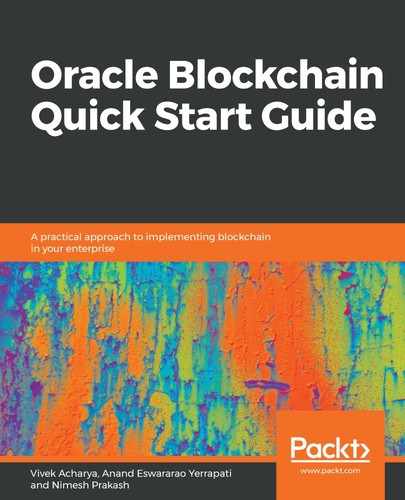Up until now, we've walk though the invoice factoring use case and modeled the business network (KonsensusChain) to realize the use case. We also learned about the integration options with the blockchain network. This section is dedicated to realizing the infrastructure of the business network. The use case we've discussed so far can be realized on a permissioned blockchain such as Hyperledger Fabric. Therefore, we will try to define the infrastructure using a cloud platform that is based on Hyperledger Fabric. We had a glimpse of OBP in the BaaS section of Chapter 1, Exploring Blockchain and BaaS. In this section, we will try to realize the business use case over the OBP.
From an infrastructure perspective, Oracle offers a cloud hosted platform for Blockchain, and it is pre-assembled with various underlying services such as compute, storage, identity management (authentication), containers, object store (embedded archiving), log and management analytics (operations), and so on. Various SaaS applications, PaaS applications, on-premise applications, and legacy applications can integrate with blockchain using Oracle's integration cloud service and can subscribe to events that are raised (emitted) from the blockchain business network.
The following diagram shows that OBP is built on top of Hyperledger Fabric:

The supplier's (seller) organization plans to start a consortium and decides for a founder-based consortium, thus adding a few more participating organizations to it. To do so, they set up blockchain instances on the OBP. Each blockchain instance contains managed containers, virtual machines, identity management, block and object storage, and Kafka, the Oracle Event Hub cloud service. In this section, we will walk through the business case and try to realize the infrastructure for it.
KonsensusChain is a founder-based blockchain network with a chaincode that takes care of financial transactions, invoice buying and selling, payments to invoicing sellers, and receiving payments from end customers. KonsensusChain is set up on OBP. It has a physical machine for each organization (founder and participant). Since it is a production deployment, its ordering is based on Kafka, and the ordering nodes are made with the founder organization. This infrastructure also includes one certificate authority (CA) for each organization. With a requirement of less than 1,000 transactions per hour, this highly available configuration will look as follows:
- Two fabric CA nodes replicated across separate virtual machines (VMs) for high availability (HA).
- The supplier (founder) will have two peer nodes, while customers and banks have two peer nodes each.
- 4 TB of storage.
- A console node replicated on each VM for HA. This console can be used to manage participants, and the founder can use it to manage the chaincode.
- The identity cloud service is integrated, which allows organizations to manage roles and identities.
- There will be a container in an isolated VM for the chaincode. You can use the console to manage the chaincode.
- The REST proxy nodes will be replicated across separate VMs for HA. These nodes offer the RESTful APIs.
- A load balancer and operations management and monitoring are supplied as well.
- An object store for configuration backup and replication of blocks across regions is provided.
- The founder (seller/supplier) will have two Kafka orderers nodes, which are replicated across separate VMs for HA.
The following diagram shows the infrastructure for the blockchain business network (KonsensusChain) that we discussed in this section:

Each organization will get a blockchain instance (one founder and five participant instances). Each instance will include nodes—a peer node, a console node, a REST proxy node, and a CA node, while the founder will have an orderer's node. Instances are also integrated with the object store for the dynamic backup of configurations and ledgers. The backup includes ledger blocks, channel configurations, checkpoints, chaincode, and nodes for provisioning files and log files. Backup and restore are automatic processes. It also uses the Oracle event hub cloud service for Kafka at the orderer's nodes. The REST proxy nodes will allow for RESTful APIs, which further helps SaaS, PaaS and their applications to connect and integrate with the blockchain business network. With all of these services, containers, and the infrastructure, OBP takes care of high availability, scalability, and the resilience of the blockchain business network.
